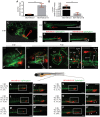Inhibition of signaling between human CXCR4 and zebrafish ligands by the small molecule IT1t impairs the formation of triple-negative breast cancer early metastases in a zebrafish xenograft model
- PMID: 26744352
- PMCID: PMC4770151
- DOI: 10.1242/dmm.023275
Inhibition of signaling between human CXCR4 and zebrafish ligands by the small molecule IT1t impairs the formation of triple-negative breast cancer early metastases in a zebrafish xenograft model
Abstract
Triple-negative breast cancer (TNBC) is a highly aggressive and recurrent type of breast carcinoma that is associated with poor patient prognosis. Because of the limited efficacy of current treatments, new therapeutic strategies need to be developed. The CXCR4-CXCL12 chemokine signaling axis guides cell migration in physiological and pathological processes, including breast cancer metastasis. Although targeted therapies to inhibit the CXCR4-CXCL12 axis are under clinical experimentation, still no effective therapeutic approaches have been established to block CXCR4 in TNBC. To unravel the role of the CXCR4-CXCL12 axis in the formation of TNBC early metastases, we used the zebrafish xenograft model. Importantly, we demonstrate that cross-communication between the zebrafish and human ligands and receptors takes place and human tumor cells expressing CXCR4 initiate early metastatic events by sensing zebrafish cognate ligands at the metastatic site. Taking advantage of the conserved intercommunication between human tumor cells and the zebrafish host, we blocked TNBC early metastatic events by chemical and genetic inhibition of CXCR4 signaling. We used IT1t, a potent CXCR4 antagonist, and show for the first time its promising anti-tumor effects. In conclusion, we confirm the validity of the zebrafish as a xenotransplantation model and propose a pharmacological approach to target CXCR4 in TNBC.
Keywords: CXCL12; CXCR4; IT1t; Inter-species crosstalk; Metastases; Triple-negative breast cancer; Xenograft; Zebrafish.
© 2016. Published by The Company of Biologists Ltd.
Conflict of interest statement
The authors declare no competing or financial interests.
Figures







Similar articles
-
CXCR4 signaling regulates metastatic onset by controlling neutrophil motility and response to malignant cells.Sci Rep. 2019 Feb 20;9(1):2399. doi: 10.1038/s41598-019-38643-2. Sci Rep. 2019. PMID: 30787324 Free PMC article.
-
CXCR4 expression is elevated in TNBC patient derived samples and Z-guggulsterone abrogates tumor progression by targeting CXCL12/CXCR4 signaling axis in preclinical breast cancer model.Environ Res. 2023 Sep 1;232:116335. doi: 10.1016/j.envres.2023.116335. Epub 2023 Jun 7. Environ Res. 2023. PMID: 37290620
-
Geminin overexpression-dependent recruitment and crosstalk with mesenchymal stem cells enhance aggressiveness in triple negative breast cancers.Oncotarget. 2016 Apr 12;7(15):20869-89. doi: 10.18632/oncotarget.8029. Oncotarget. 2016. PMID: 26989079 Free PMC article.
-
CXCR4/CXCL12 blockade therapy; a new horizon in TNBC therapy.Med Oncol. 2025 Apr 11;42(5):161. doi: 10.1007/s12032-025-02705-5. Med Oncol. 2025. PMID: 40216617 Review.
-
Role of the CXCR4/CXCL12 signaling axis in breast cancer metastasis to the brain.Clin Exp Metastasis. 2010 Feb;27(2):97-105. doi: 10.1007/s10585-008-9210-2. Epub 2008 Sep 24. Clin Exp Metastasis. 2010. PMID: 18814042 Review.
Cited by
-
Zebrafish Microenvironment Elevates EMT and CSC-Like Phenotype of Engrafted Prostate Cancer Cells.Cells. 2020 Mar 26;9(4):797. doi: 10.3390/cells9040797. Cells. 2020. PMID: 32225005 Free PMC article.
-
The Zebrafish Xenograft Models for Investigating Cancer and Cancer Therapeutics.Biology (Basel). 2021 Mar 24;10(4):252. doi: 10.3390/biology10040252. Biology (Basel). 2021. PMID: 33804830 Free PMC article. Review.
-
Temporal and spatial characteristics of tumor evolution in a mouse model of oral squamous cell carcinoma.BMC Cancer. 2022 Nov 24;22(1):1209. doi: 10.1186/s12885-022-10256-5. BMC Cancer. 2022. PMID: 36424557 Free PMC article.
-
CXCR4 signaling regulates metastatic onset by controlling neutrophil motility and response to malignant cells.Sci Rep. 2019 Feb 20;9(1):2399. doi: 10.1038/s41598-019-38643-2. Sci Rep. 2019. PMID: 30787324 Free PMC article.
-
Zebrafish xenografts in breast cancer research.Front Immunol. 2025 Jul 10;16:1540610. doi: 10.3389/fimmu.2025.1540610. eCollection 2025. Front Immunol. 2025. PMID: 40709187 Free PMC article. Review.
References
-
- Balabanian K., Lagane B., Infantino S., Chow K. Y. C., Harriague J., Moepps B., Arenzana-Seisdedos F., Thelen M. and Bachelerie F. (2005). The chemokine SDF-1/CXCL12 binds to and signals through the orphan receptor RDC1 in T lymphocytes. J. Biol. Chem. 280, 35760-35766. 10.1074/jbc.M508234200 - DOI - PubMed
Publication types
MeSH terms
Substances
LinkOut - more resources
Full Text Sources
Other Literature Sources
Molecular Biology Databases

